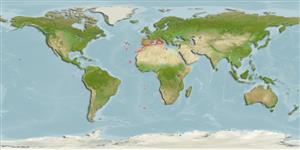>
Carangiformes (Jacks) >
Carangidae (Jacks and pompanos) > Caranginae
Etymology: Trachurus: Greek, trachys, -eia, -ys = rough + Greek, oura = tail (Ref. 45335).
Environment: milieu / climate zone / depth range / distribution range
Écologie
marin benthopélagique; océanodrome (Ref. 51243); profondeur 305 - 370 m (Ref. 56504). Subtropical; 45°N - 41°S, 32°W - 17°E
Eastern Atlantic: southern Bay of Biscay to southern Morocco including Azores, Madeira , Canary Islands, Tristan de Cunha and Gough Islands. Also known from the western part of the Mediterranean Sea. Reported from Mauritania (Ref. 55783). Is also reported from the eastern part of Mediterranean by several references that may need confirmation - see the list of countries (NB).
Length at first maturity / Taille / Poids / Âge
Maturity: Lm 24.7, range 24 - 49.5 cm
Max length : 60.0 cm TL mâle / non sexé; (Ref. 7097); common length : 25.0 cm FL mâle / non sexé; (Ref. 3397); âge max. reporté: 18 années (Ref. 109005)
Adults are found at depths ranging from 305 to 368 m in the eastern Ionian Sea (Ref. 56504). They can be seen up to depth of 370 m (Ref. 4233). They are confined to neritic zones of island shelves, banks and sea mounts; a schooling species (Ref. 4233). Known to migrate between the coast of Sahara and the offshore seamounts possibly reaching the Cape Verde Islands (Ref. 26139). They feed mainly on crustaceans (Ref. 4233). Eggs are pelagic (Ref. 4233).
Smith-Vaniz, W.F., 1986. Carangidae. p. 815-844. In P.J.P. Whitehead, M.-L. Bauchot, J.-C. Hureau, J. Nielsen and E. Tortonese (eds.) Fishes of the north-eastern Atlantic and the Mediterranean. UNESCO, Paris. vol. 2. (Ref. 4233)
Statut dans la liste rouge de l'IUCN (Ref. 130435)
Menace pour l'homme
Harmless
Utilisations par l'homme
Pêcheries: commercial
Plus d'informations
RéférencesAquacultureProfil d'aquacultureSouchesGénétiqueElectrophoresesHéritabilitéPathologiesTraitementNutrientsMass conversion
Outils
Articles particuliers
Télécharger en XML
Sources Internet
Estimates based on models
Preferred temperature (Ref.
123201): 9.6 - 14.1, mean 13.1 °C (based on 5 cells).
Phylogenetic diversity index (Ref.
82804): PD
50 = 0.5001 [Uniqueness, from 0.5 = low to 2.0 = high].
Bayesian length-weight: a=0.00933 (0.00798 - 0.01091), b=2.96 (2.93 - 2.99), in cm total length, based on LWR estimates for this species (Ref.
93245).
Niveau trophique (Ref.
69278): 3.3 ±0.42 se; based on food items.
Generation time: 5.6 (3.5 - 6.8) years. Estimated as median ln(3)/K based on 10
growth studies.
Résilience (Ref.
120179): Milieu, temps minimum de doublement de population : 1,4 à 4,4 années (K=0.2-0.4; assuming tm=2-4).
Prior r = 0.49, 95% CL = 0.32 - 0.73, Based on 2 stock assessments.
Fishing Vulnerability (Ref.
59153): Moderate vulnerability (40 of 100).
Climate Vulnerability (Ref.
125649): Moderate vulnerability (37 of 100).
Nutrients (Ref.
124155): Calcium = 147 [88, 283] mg/100g; Iron = 2.46 [1.41, 4.55] mg/100g; Protein = 18.2 [17.3, 19.2] %; Omega3 = 0.267 [0.158, 0.459] g/100g; Selenium = 37.1 [18.2, 73.5] μg/100g; VitaminA = 22.5 [5.0, 115.0] μg/100g; Zinc = 2.08 [1.45, 3.05] mg/100g (wet weight);
